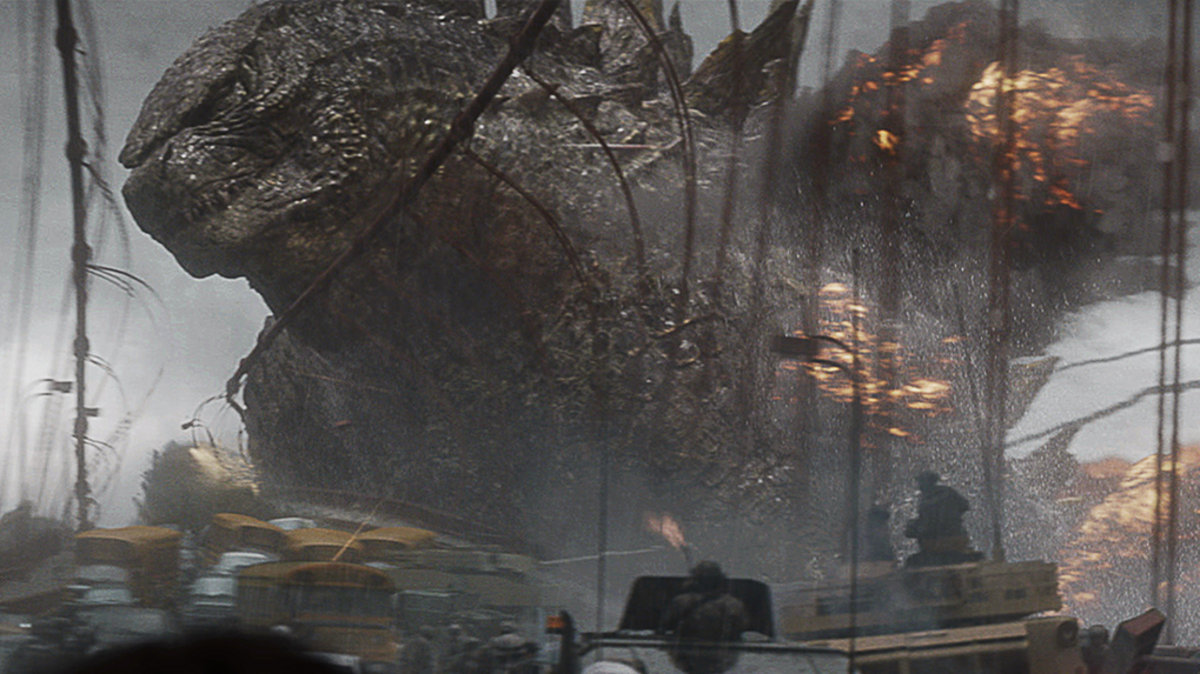In a house in San Francisco, Sam Brody, a 5 year old boy who dreams of dinosaurs. Waking from his slumber we see the cause of his phantoms, toy models that dominate the foreground of the shot. It doesn’t matter that his array of beasts lived in different periods millions of years apart; a child’s imagination can travel faster than light. Beyond those moulded fossils we see a monolith, a flat screen television, and “the drug of the nation, breeding ignorance and feeding radiation.”
Sam looks closer, is he still dreaming? Are his dreams now reality? Titans destroy America live on CNN. “Look mummy, dinosaurs,” he says with typical Spielbergian understatement. This isn’t his direct work but the shadow of the Beard’s hand can be seen guiding Gareth Edwards’ reboot of “Godzilla.” This is slow burn opening hour, teasing, delaying, and hiding the cyclopean in plain sight, a David Copperfield illusion with rampaging daikaiju. Did they lay waste to Vegas due to a legal wrangle over ticket prices?
Edwards was the technical whizz behind the low budget “Monsters” and a brave choice to head such a towering franchise. Like his subject Edwards’ blockbuster has stayed hidden, letting the other summer movies do their stalking. Even his opening credits are thrillingly illusive; each name redacted over embellished footage of the Castle Bravo detonation Bikini Atoll and other nuclear devices in the South Pacific. Godzilla’s spines race through the water like volcanic islands as we piece together the real reasons behind the flurry of atomic tests in the 1950s.
“Godzilla’s” sheer sense of scale would make H.P. Lovecraft blush. Great Cthulhu, the “Mountain that walked or stumbled,” wouldn’t stand a chance against the creatures that dwarf the heavens but sliver back into the gargantuan depths of the earth. What dark intelligence sired such monstrosities? Edwards constantly humanises the story, pulling back from the titanic to the smallest detail, a tank on the Golden Gate Bridge, a gunner on a battleship or a Chinese lantern strung across San Francisco’s Chinatown, a delicate symbol of hope, paper thin lighting the way from the apocalypse.
The human characters are an afterthought but not without their own weight. Ken Watanabe and Sally Hawkins as the stoic scientists, Bryan Cranston as the jittery nuclear plant supervisor full of conspiracy theories, David Strathairn as the straight laced Admiral and Aaron Taylor-Johnson as the soldier put through the purgatory of collapsing monorails, bridges and skyscrapers to be reunited with his young family.
Still none of his Herculean labours compare to his Halo jump as skydivers plummet to oblivion trailing red and falling to the stygian moans and cries of the monolith from “2001.” After all children dream in fast-forward and movie directors have the gift of pressing record. Gareth Edwards is Sam Brody, innocent and direct and he is Godzilla, bred from the radiation of Toho re-runs on Saturday morning television breathing nuclear fire down the throats of his audience.

